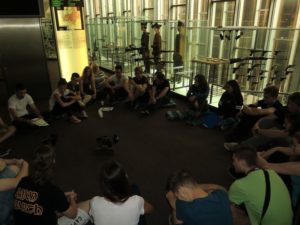
From the student´s conference in Banska Bystrica, September 2015, photo: Jan Špringl, Terezin Memorial
Two years ago, the Terezín Memorial was addressed by the Museum of the Slovak National Uprising (SNP) located in Banská Bystrica with a request to cooperate on a joint Slovak-Czech project
aimed at grammar school students in the Czech and Slovak Republics. The project was subsequently adjusted so that the registered Czech students worked on the issues related to the Slovak history during the Second World War, and, on the contrary, the Slovak students dealt with the Czech history of 1939-1945. Their findings were to be eventually presented at a conference in Banská Bystrica.
Participating institutions (The SNP Museum, the Terezín Memorial and the Lidice Memorial) compiled a list of appropriate themes for the students registered in the project, and, at the same time, provided the young researchers with basic sources in electronic form to help them process the issues. The rest was up to the students themselves, possibly their teachers. The project was joint by two schools in the Czech Republic (Grammar School of J. V. Jirsík in České Budějovice and Grammar School in Kladno) and three schools in the Slovak Republic (Grammar School of Jozef Gregor Tajovský in Banská Bystrica, Evangelical Grammar School in Banská Bystrica and Grammar School of Andrej Sládkovič in Banská Bystrica).
The conference was held on 16th and 17th September 2015 in the newly opened education centre of the SNP Museum in Banská Bystrica. The first day was dedicated to students’ papers and presentations of their schools. In terms of historical themes, the Czech students viewed the Slovak National Uprising from the perspective of the uprising and Holocaust survivors in the Slovak Republic. The Slovak students then processed the following topics: Reflection on anti-Jewish laws and regulations in the memories of the Jewish population in the Protectorate of Bohemia and Moravia, Heydrich terror in the memories of the Terezín ghetto prisoners, and the formation of Terezín and Lidice as memory sites in postwar Czechoslovakia. The second day of the conference consisted of tours and activities in the expositions of the SNP Museum and a visit to the national cultural monument Kaliště – a settlement burnt down in March 1945.
Šp

